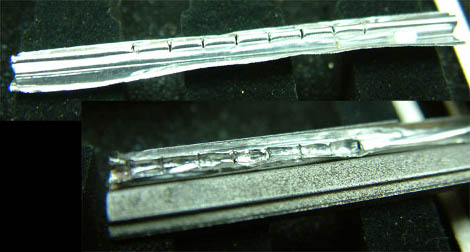

__ __ __ ___ / // /__ _____/ /__ ___ _ / _ \___ ___ __ / _ / _ `/ __/ '_/ / _ `/ / // / _ `/ // / /_//_/\_,_/\__/_/\_\ \_,_/ /____/\_,_/\_, / retro edition /___/Now optimized for embedded devices!!
| About | Successes | Retrocomputing guide | Email Hackaday |

Looks like the men in black have paid [Kyle McDonald] a little visit. The United States Secret Service is investigating him for fraud and related activity for his People Staring At Computers project. We just took a look at that one yesterday, and were thankful that all he was doing was taking people’s pictures and not stealing their information. Looks like [Uncle Sam] wasn’t being as lenient–or it could have been Apple that did the complaining since mums the word from the corporate giant. [Kyle's] also keeping his mouth shut after soliciting the advice of the Electronic Frontier Foundation.
Since details are scarce, it’s time to play armchair lawyer. Let us know in the comments what you think [Kyle] might be up against, and whether we’ll see this thing hit the courts or not. And remember not to take those comments as legal advice since none of us actually know what we’re talking about.
By the way, the gentleman seen above isn’t [Kyle], he’s one of the unsuspecting ‘victims’ with some wikimedia commons slapped in for effect.
[Thanks Craig, David, and others]

Hackaday regular [Mikey Sklar] is no stranger to body modifications. He enjoys tweaking his body in ways that help him with day to day tasks, including a ruler tattoo on his arm and an RFID chip embedded in the web of his hand. Lately, he has been toying around with a less invasive means of getting a better feel for magnetic fields in his surroundings.
Turned on to magnetic rings by a friend, he now wears an epoxy-coated rare earth ring every day, changing the way he interacts with the world. He says that besides the obvious ability to tell when he’s near iron-heavy material, he can also feel cell phone calls, as the speaker draws the ring closer while producing sound.
He says that holding the electric cord of his tea kettle gave him the biggest start, making him feel as if he had been electrocuted, minus the actual shock.
While it’s not the most high-tech hack, [Mikey] is quite happy with the “sixth sense” this reasonably price ring has been able to provide – we just might have to try it out ourselves.

For those who do fancy photography, setting up the lighting ends up being one of the larger tasks of each session. There are flashes out there that can be controlled via a remote control to help ease the process, but they can cost a considerable amount more. [Dsvilko] shares with us a fairly simple circuit that allows you to use a tv remote to control your flash. He’s using a picaxe 08m and he states that before this project, he had never messed with microcontrollers. We say great job on your first microcontroller project. You can catch a video of it in action after the break.
[via Makezine]

Apparently it’s been around for fifteen years but using foil impressions to pick locks is new to us. This is similar to using bump keys but it works on locks that are supposedly much more secure. This method uses a heavy gauge aluminum foil to grab and hold the pins in the correct place for the lock to be turned. The foil is folded over and slits are cut where each pin will fall. It is then inserted into a lock on a tool shaped like a key blank. Jiggle the tool for a bit and the cylinder will turn. This just reminds us that we’re much more dependent on the good will of our fellow citizens to not steal our stuff, rather than the deterrent that a lock provides.
We’ve embedded a detail and fascinating demonstration of this method after the break. The materials in the video are from a Chinese-made kit. We’re not sure where you find these types of locks, but we don’t feel any less secure since our keys could be obtained from a distance anyway.
Update: Video now embedded after the break. The link is down but you can try the Google Cache version.
sign-language sent us a link to some instructions for turning your old commodore’s sid chip into a midi controlled synth capapble of pumping more grooves than you ever thought possible. i was really excited to post a commodore hack, but then i scrolled down and saw this image. c64 slayings are really hard for me to stomach.
let’s keep it clean, folks.